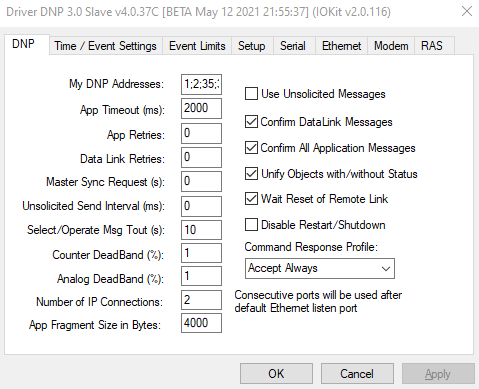
DNP tab
The available options on this tab are described on the next table.
Available options on the DNP tab
Option |
Description |
|---|---|
My DNP Addresses |
DNP Address of this Driver. It is possible to inform more than one DNP Address by providing a numerical list separed by semicolon. Ex: 1;3;5. The first address at the list will be considered the main or default DNP Address. |
App Timeout (ms) |
Maximum time the application layer waits for a full response from the Data Link layer. If the Data Link layer is currently receiving a request, this time is automatically extended up to the end of Data Link's reception. The default value of this option depends on the baud rate used. Data Link's time-out, or byte by byte, is defined by IOKit's time-out, configured on the Setup tab. The value in this option must be greater or equal to Data Link's time-out |
App Retries |
Number of I/O retries performed by the application layer in case of a transaction error. Default value of this option is 0 (zero) |
Data Link Retries |
Number of I/O retries performed by the Data Link layer in case of a transaction error. Default value of this option is 0 (zero) |
Master Sync Request (s) |
Time interval in which this Driver requests a clock syncing to a Master, which may or may not be accepted, depending on the configuration of the Enable Time Sync option on the Time / Event Settings tab. To disable sending, configure this option with the value 0 (zero) |
Unsolicited Send Interval (ms) |
Defines a time interval in which this Driver checks for events of Classes 1 (one), 2 (two), or 3 (three) available for sending through unsolicited messages, if the Use Unsolicited Messages option is enabled. The Master side can also enable or disable sending unsolicited messages from the Slave by sending functions Enable Unsolicited Messages (20) and Disable Unsolicited Messages (21) |
Select / Operate Msg Tout (s) |
Maximum time, in seconds, between a Select command and an Operate command. After this time, the Operate command is no longer accepted by this Driver |
Counter DeadBand (%) |
Informs a dead band, as a percentage, to notify events for counters |
Analog DeadBand (%) |
Informs a dead band, as a percentage, to notify events for analog points. To specify individual tag dead band, check the chapter Tag Addressing. |
Number of IP Connections |
Defines the number of simultaneous connections, TCP or UDP, accepted from a TCP/IP port defined on the Ethernet tab. For example, when defining three connections and a port 20000, then this Driver can receive three connections on ports 20000, 20001, and 20002. Users can define a value between 1 (one) and 5 (five) connections |
App Fragment Size in Bytes |
Inform the application fragment size. The standard value for most systems is 2048 bytes. |
Use Unsolicited Messages |
Informs whether this Driver sends unsolicited messages |
Confirm DataLink Messages |
Informs whether this Driver requests confirmation messages on the Data Link layer |
Unify Objects With/Without Status |
If this option is set, the different object variations will be unified in a single variation with status. Example: If the application has digital tags object 1 variation 1 and also variation 2, all indexes will be unified with variation 2.
If this option is NOT set, all different variations will be kept as independent objects. Example: If the application has a tag object 1 variation 1 index 25, and another tag object 1 variation 2 index 26, they will be reported at Class 0 (integrity) request as different objects. It is not recommendable that objects with different variations share the same indexes, because both can generate events with the same index, causing interpretation mistakes. This option actually is valid for objects/variations 101, 301, 1001, 1101 and 3004. |
Wait Reset of Remote Link |
Instructs this Driver to only respond to communications after receiving a Reset of Remote Link command from a Master. Default value of this option is selected |
Disable Restart / Shutdown |
Disables the command to shut down the computer, which can be sent by a Master using DNP's function 13 (Cold Restart) |
Informs the type of handling is given to commands requested to this Driver (Object 12 Variation 1 and Object 41 Variations 1, 2, 3, and 4). The available options are Deny Always: All commands are responded negatively and instantaneously, with their Status field reporting a code 4 (four, unsupported command), Accept Always: All commands are responded positively, with their Status field reporting a code 0 (zero, command OK), after the application read the respective command Tag. This indicates that the command was understood and the application is going to process it, and Wait for Application Response: Commands are only responded after the application reads and writes the respective Tag. The purpose of reading is for the application to understand that there was a request from a Master, which is then sent to another Driver or system output. After this processing, the application must write back to the Tag the same value read to indicate a successful processing, or a different value to indicate a failure. Please check topic Command Handling for more information |
NOTE |
A script is needed to send a message from a Driver to another. For more information, please check topic Event Syncing with Redundancy. |